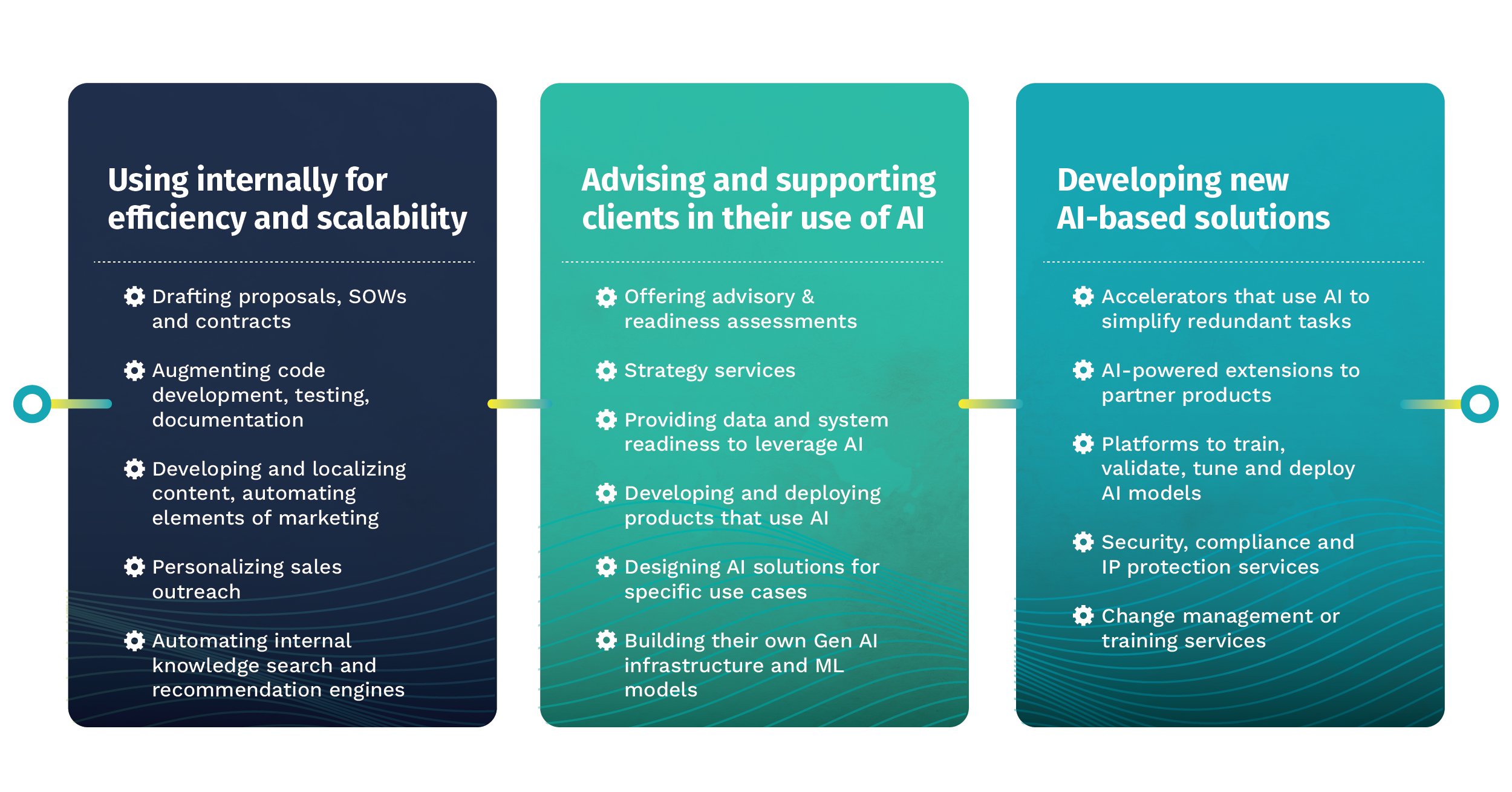“The biggest companies to be built in AI over the next 24 months will be services companies helping the largest enterprise in the world implement and adopt AI internally.”
That quote from Harry Stebbings, a well known tech VC and podcaster, is music to the ears of a growth equity investment firm specializing in technology services.
Harry is right. Tech consultancies, digital services, product engineering firms, and managed service providers are all going to play a pivotal role in the adoption of Artificial Intelligence, especially when it comes to large enterprises that can’t afford to get it wrong.
It’s why Accenture recently announced a $3 billion investment in AI. And the company is not alone. It seems every services firm is jumping into the AI game – some deeper and faster than others. In just the last few months:
- Multiple firms are doubling down with Google Cloud on AI, including Deloitte, TCS, Wipro and CapGemini
- PWC is investing $1 billion over the next three years to scale its AI capabilities, expanding its relationship with Microsoft and Azure
- IBM introduced its own AI platform, Watsonx, and announced it would add more than 1,000 consultants to help clients build generative AI apps
- Globant announced an AI challenge awarding $200,000 for ideas on how AI can transform business
Every services firm will need to figure out where AI, and specifically generative AI, fits into their strategy and ambitions. However, going in blindly has consequences. Before I get to the consequences, let’s talk about why this is such an important moment for services.
Why is AI so disruptive to services?
AI didn’t happen overnight. The big software platforms have been incorporating AI into their products for years, and the global systems integrators (GSIs) have been making investments for years as well. Don’t believe me? Check out Globant’s AI Manifesto from early 2019.
But it was the open sourcing of ChatGPT that captured people’s imagination. It showed the average person what’s possible with AI in an easy to understand way, and it democratized access to the Large Language Models that power generative AI. It also kicked off a feeding frenzy of investment that will make crypto and Web3 look small in comparison.
Some call it the iPhone moment. Others compare it to the introduction of the first web browser. I liken it to the introduction of cloud computing (which in our opinion set the stage for generative AI). Whatever analogy you use, it’s clear AI will eventually impact nearly every aspect of professional services — from how work gets done, to what solutions are delivered, to who firms hire, to how they train, to how they operate internally.
It’s clear AI will eventually impact nearly every aspect of professional services — from how work gets done, to what solutions are delivered, to who firms hire, to how they train, to how they operate internally.
It doesn’t matter if you’re a GSI focused on multi-million dollar digital transformation programs, or a small marketing agency supporting local businesses, AI is going to change what you do and how you do it.
The CEO of Cognizant, Ravi Kumar, talked about how Cognizant is using AI in the company’s most recent earnings announcement, saying an AI-led, automation-first approach to IT operations can “reduce operational costs by 25% to 45%, reduce mean time to delivery and mean time to detect by 30% to 50%, and reduce FTEs by 15% to 30% compared with the use of traditional approaches.”
This highlights both sides of AI. On one hand AI has the potential to dramatically drive down operational costs while improving performance and speeding innovation. However, it also means less people and consultants are required, which is a pretty significant impact on businesses that derive revenue by selling people’s time. That is going to present both opportunities and challenges for services firms.
This situation has been the case with most technology advances. Services companies have always had to adapt and figure out how to use these changes to their benefit. However, it’s going to happen faster this time and firms need to be ready.
Where and when should firms invest in AI?
Today, we see services firms incorporating AI (usually generative AI) in three primary ways:
- Incorporating internally for efficiency and scale
- Helping clients incorporate AI into their products or operations
- Developing new AI-based solutions

However, not every services company is ready to jump into the deep end of the AI pool. In fact, we’d argue that for most (unless you have gobs of cash or resources to invest) it’s better to wade in slowly. It is still early days for this technology and it is moving fast. If you invest too much, too soon, in the wrong areas, or in the wrong way, you could drown.
Not every services company is ready to jump into the deep end of the AI pool. In fact, we’d argue that for most (unless you have gobs of cash or resources to invest) it’s better to wade in slowly…If you invest too much, too soon, in the wrong areas, or in the wrong way, you could drown.
Here are a few considerations as you think about where to invest your increasingly precious time and money:
Have you started using AI internally?
Before you attempt to advise customers, make sure you’re using it internally so you can see the opportunities and risks firsthand. It’ll also make the sales pitch a lot easier, and will make every one of your consultants smarter on the topic.
Where are your customers on the AI maturity curve?
Not every customer is ready to implement AI-enabled solutions. Do some research to figure out where your customers are on the adoption curve, and how you uniquely can help bring them along.
How are your partners thinking about AI?
Most software vendors are investing in AI, but at different levels. Know what’s on their roadmap. It’ll make you a better partner, and may prevent you from wasting your time on IP that could be embedded in the product in the next six months.
Where do customers really need YOUR help?
Understand where your expertise lies, and where you have permission to play. If you specialize in healthcare, identify those use cases. Identify the white space, and make that space yours.
Is my team prepared?
This is the most important question. If you don’t have a team capable (or willing) to execute on what you’re trying to do, you won’t be successful and you could end up alienating your team and hurting your reputation. That will have far-reaching consequences.
If you feel like your team is ready and willing, that there is a clear opportunity where you have permission to play, and your customers and partners are pulling you there, by all means, go for it!
But for the majority of firms out there, be measured about it. AI is at the peak of the hype cycle and so much is going to change in the next few months and years. The distraction factor is high, and you don’t want to waste your resources, panic your team or put your customers at risk just to get a first mover advantage. Cloud computing has been around for a quarter of a century, yet many mission-critical systems remain on-premise (with many still on mainframes).
Progress takes time. You just need to be ready.


